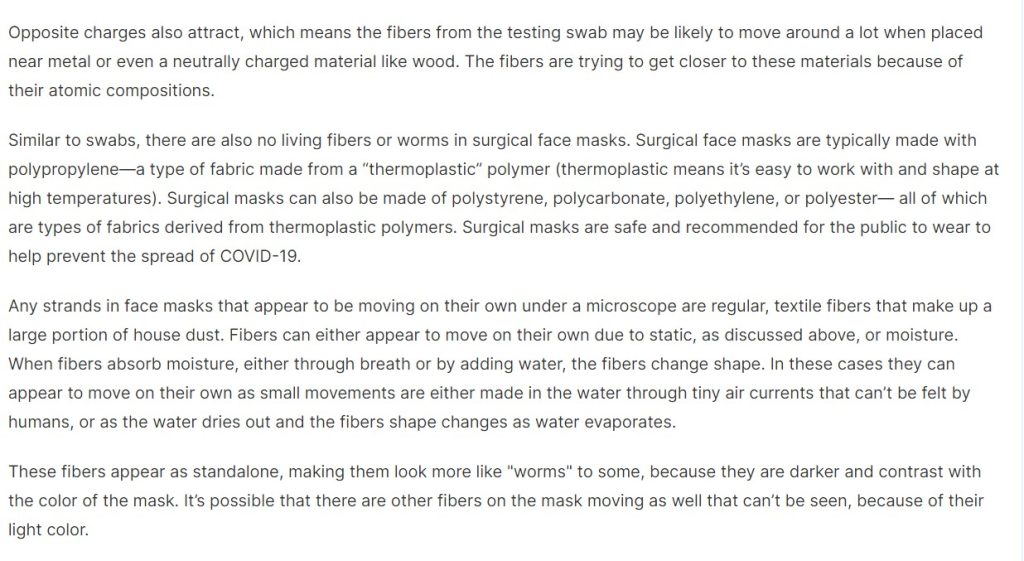Authors
Vasudha noticed the growing problem of mis/disinformation online after studying New Media at ACJ in Chennai and became interested in separating facts from fiction. She is interested in learning how global issues affect individuals on a micro level. Before joining Newschecker’s English team, she was working with Latestly.
Amid a spike in coronavirus cases in the country, an old video claiming to show ‘worms’ in disposable masks, which in-turn cause COVID when inhaled, has been revived again. The viral video shows a man setting a bunch of disposable masks on fire while claiming that his ‘research’ proves the presence of ‘black-coloured tiny worms’ inside face masks.
The COVID-19 positivity rate has been steadily increasing in India, prompting Union Health Ministry issued revised comprehensive guidelines for management of COVID-19 in children and adolescents on January 20, 2022, and re-emphasised on ‘COVID Appropriate Behaviour’ including wearing masks, washing hands, and vaccination among others to prevent the spread of the virus. It is in this context that the video is going viral again.
The viral video goes on to show the unidentified man zooming into a mask set on top of a cup filled with hot water. As the camera zooms in further, one observes black thread-like particles move, wherein he claims that the ‘worms’ are seen ‘coming to the surface’ due to the steam.
The video has been shared by many users online and Newschecker has also received the same video on our WhatsApp tipline (+91 9999499044) requesting it to be fact checked.

OLD CLAIM RESURFACES
A simple keyword search for ‘Face Masks Have Worms’ on Facebook led us to several such posts from mid-last year. In April 2021, when India was experiencing a devastating second wave of COVID-19 cases, the same video claiming to show that face masks have worms was doing the rounds of social media platforms.
Coronavirus outbreak and the resultant pandemic has been the subject of much misinformation. Earlier this January, Newschecker fact checked a video in which a Delhi-based doctor, Dr Tarun Kothari, was seen making several misleading claims regarding coronavirus and vaccinations including that wearing facemasks leads to reduction of oxygen levels in the body. You can read it here.
For more Covid-19 related misinformation click here
Fact Check/Verification
Newschecker contacted Dr Raman R. Gangakhedkar, a member of WHO’s expert group for examining the origins of emerging and re-emerging pathogens of epidemic and pandemic potential, including SARS-CoV-2 and former head of epidemiology and communicable diseases at the Indian Council of Medical Research, who dismissed the claim. Dr Gangakhedkar said, ”That’s absolutely incorrect. There is no such thing as worms in masks. Worms don’t fly in the air.. Even if they were to be filtered. That doesn’t happen.”
What are surgical masks made of?
According to an article titled ‘Why might COVID-19 test swab fibers move around?’ by Meedan’s Heath Desk, the surgical face masks are made with either polypropylene, polystyrene, polycarbonate, polyethylene, or polyester – all made of thermoplastic polymer, making it easy to work with and shape at high temperatures.
It adds, “Any strands in face masks that appear to be moving on their own under a microscope are regular, textile fibers that make up a large portion of house dust. Fibers can either appear to move on their own due to static, as discussed above, or moisture. When fibers absorb moisture, either through breath or by adding water, the fibers change shape. In these cases they can appear to move on their own as small movements are either made in the water through tiny air currents that can’t be felt by humans, or as the water dries out and the fibers shape changes as water evaporates.”

The article explains that standalone fibres are darker in contrast to the colour of the masks, they could look more like ‘worms’ and that real worms would not be able to survive in or on a face mask as it is “too dry.” It added that real worms look very different under a microscope than fibers, with visible organs and other distinguishable characteristics.
In addition, we also came across a tweet by the government’s PIB Fact Check, dated January 19, 2022, which dismissed the claim that face masks have worms in them and called it fake. It added that masks made as per scientific standards do not contain any worms.
Conclusion
The viral claim that face masks have worms in them is false and devoid of facts. Wearing masks is an important measure in reducing the transmission of coronavirus.
Result: Fabricated Content/False
Sources
Dr Raman R. Gangakhedkar, Member, WHO’s expert group for examining the origins of emerging and re-emerging pathogens of epidemic and pandemic potential, and former head of epidemiology and communicable diseases at the ICMR.
Health Desk: https://health-desk.org/articles/why-might-covid-19-test-swab-fibres-move-around
PIB Fact Check
If you would like us to fact check a claim, give feedback or lodge a complaint, WhatsApp us at 9999499044 or email us at checkthis@newschecker.in. You can also visit the Contact Us page and fill the form.
Authors
Vasudha noticed the growing problem of mis/disinformation online after studying New Media at ACJ in Chennai and became interested in separating facts from fiction. She is interested in learning how global issues affect individuals on a micro level. Before joining Newschecker’s English team, she was working with Latestly.



